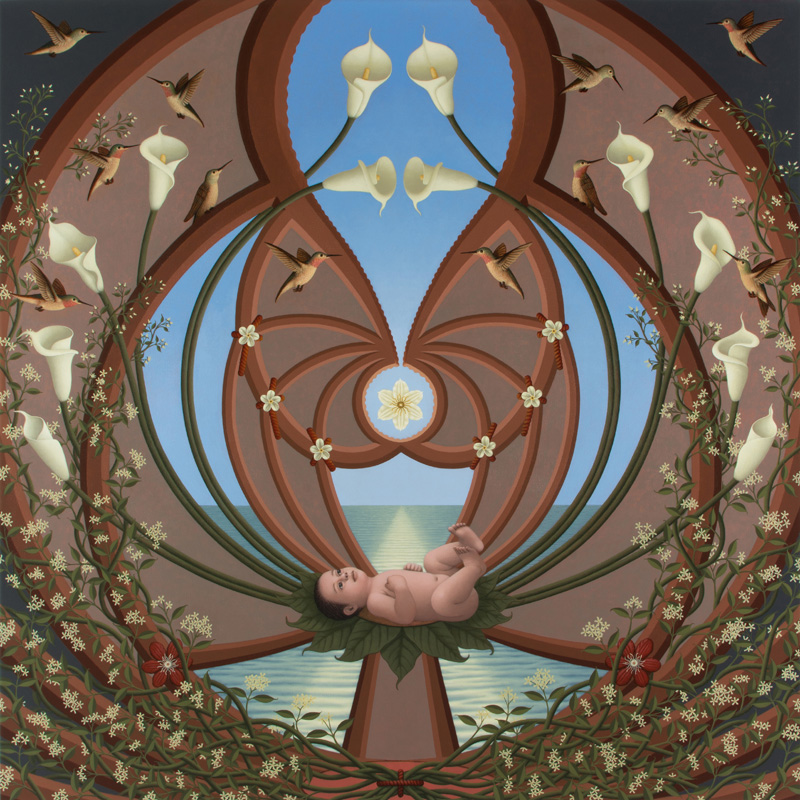
 |
| The Flowering 2017/2020, acrylic on canvas 54 x 54 in. |
The Flowering |
I think of The Flowering as a life affirming work. Flowers, birds, sky, sea, and an infant come together to form a depiction of life's renewal. It suggests springtime. Vines grow upward with new leaves and flowers. Hummingbirds rest, flit about and hover near flowers seeking nourishment. The calla lilies arc up to form a type of candelabra. Their blossoms functioning as trumpets announcing the birth of spring. An infant, resting on a bed of large leaves, gazes up in wonderment at all the activity. The composition of The Flowering is symmetrical. A large complex geometric structure dominates the picture. Set against a clear blue sky and a tranquil sea the structure is constructed of two sets of ribs that radiate out symmetrically from two centrally located points – one from the bottom center and the other from beneath the infant. The ribs are made of both organic and inorganic materials and arc upward creating circular and oval forms. The organic ribs are the stylized stems of calla lilies while the inorganic ribs are architectural and act as a type of lattice work on which the vines can grow. Between some of the ribs are solid areas that prevent a view of the sky and sea beyond. They unify the structure and provide a space for the birds, flowers and vines to inhabit. Overall, the structure is a kind of trellis or architectural screen that can be seen as an abstract flower opening up. Running vertically down the center of The Flowering is a series of strategically placed elements. These serve as points of visual interest. At the top are four calla lily flowers framed within a large inverted teardrop shape of blue sky. Further down is a clematis flower framed within a small circle. It is located at the center of the canvas and can be seen as a de facto sun rising in the sky. Next is the vanishing point on the horizon where the sunlight, cast on the undulating waves of the sea, fades in the distance. This is followed by the infant who is located at the focal point of many of the ribs. Because of this the infant becomes the focal point of much of the composition. Finally at the bottom is an elliptical form that functions as a platform for a bundle of vines that are tied at their center by a red rope in the form of a cross. Another visually interesting aspect of The Flowering is the varying size, shape, and relationships of the flowers. There are four types of flowers represented in the painting - calla lilies, star jasmine, clematises, and plumerias. The calla lilies are the largest. Because of their size and shape, they take on a sculptural quality. This sets up a dynamic relationship with the clusters of small five-petal star jasmine flowers, which elevates the characteristics of the other. There are three medium size six-pedal clematises – a centrally located white one that represents the sun and two red ones that function as architectural bosses. Together they form a stabilizing triad. The last flowers are plumerias. There are six of the smaller five-pedal flowers located near the center of the picture. They frame the larger white clematis and like the red clematises they too function as architectural bosses that decorate the juncture of where ribs meet. All the flowers, except for the two red clematises, are white and symbolically represent purity, innocence, resurrection, and rebirth. The Flowering depicts the dawning of a new day. The sky is clear, the sea is calm, the vines grow skyward, and the flowers are in full bloom. The flowers of the star jasmine twinkle and rise like the exhilarating effervescence in some magical floral elixir. The hummingbirds hover and dart carefreely about. The infant is healthy and at peace. The unity and wonder of life and nature are on display. - Brian Mains, May 2023 |